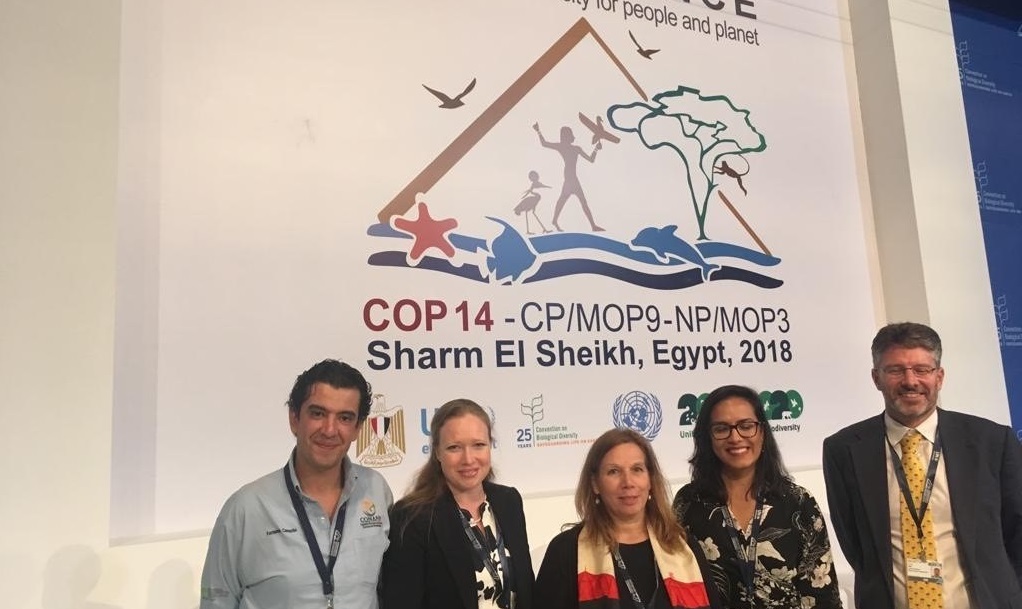COP14: SEEA in Support of the Post-2020 Biodiversity Framework

L-to-R: Fernando Comacho (CONANP, Mexico), Kristal Maze (SANBI, South Africa), Alessandra Alfieri (UNSD), Luana Duarte (Ministry of Environment, Brazil) and Neville Ash (UNEP-WCMC)
With 2020 nearing, the fourteenth UN Biodiversity Conference (COP14) in Sharm El Sheikh, Egypt, was an important opportunity for parties to continue shaping a post-2020 Biodiversity Framework. Natural capital accounting has a pivotal role to play in this framework and recognition of the role of natural capital accounting for biodiversity has been growing. For example, natural capital accounting was previously identified as a priority under the Gaborone Declaration for Sustainability in Africa, under which 13 countries have committed to integrating the value of natural capital into national accounting. More recently, in a significant development on the eve of COP14, the African Ministerial Summit on Biodiversity on 13 November 2018 affirmed natural capital accounting as one of Africa’s biodiversity priorities.
Against this backdrop, the United Nations Statistics Division (UNSD) and the United Nations Environment Programme-World Conservation Monitoring Centre (UNEP-WCMC) hosted side event at the COP, Natural Capital Accounting to Support the Post-2020 Biodiversity Framework, on 22 November. The side event, which was attended by nearly 80 participants, explored the role natural capital accounting and the SEEA can play in the post-2020 agenda.
The side event showcased country experiences from three partner countries of the E.U.-funded Natural Capital Accounting and Valuation of Ecosystem Services (NCAVES)—Brazil, Mexico and South Africa. The panel discussion, chaired by Neville Ash (UNEP-WCMC), illuminated several key messages on how the SEEA can best contribute to the Post-2020 Framework. The SEEA currently addresses several Aichi Biodiversity Targets, in particular Target 2, and the importance of the SEEA’s mainstreaming role for the post-2020 Agenda was stressed by all panellists. Kristal Maze of the South African National Biodiversity Institute (SANBI) noted that as part of mainstreaming efforts, natural capital accounting has been included in the South Africa National Biodiversity Strategy and Action Plan (NBSAP) and the National Statistics Development Plan as a priority. It was noted that it is important to engage policy makers at every step of the development of accounts to ensure the accounts can effectively meet policy needs.
Another key message was the potential of accounts to forge partnerships across key groups of stakeholders. Addressing biodiversity loss and measuring progress towards the Aichi Biodiversity Targets cannot be achieved by one group alone. Through SEEA accounts and the NCAVES project, Brazil, Mexico and South Africa have all seen partnerships forged between national statistical offices, ministries of environment, ministries of planning and finance and other line ministries. Through the integrated nature of the SEEA, stakeholders across different disciplines have been able to find common footing and a common language.
One other key message was the value of the SEEA in supporting indicator frameworks. Panellists and participants underlined the importance of having methodologically sound indicators that go beyond GDP to help measure sustainable development. Although the SEEA is not an indicator framework, panellists highlighted how the systematic and methodologically sound approach of the SEEA led to coherent indicators. Many at the event also highlighted the accounts as the basis for the derivation of aggregates and indicators that could complement existing indicators such as GDP, the Red List Index, etc.
Lastly, panellists and participants alike stressed the role of the SEEA for policy coherence. While there has been progress towards the Aichi Biodiversity Targets, there is certainly a need to accelerate progress and create momentum behind the post-2020 Agenda. Many at the COP14 recognized that traditional efforts to fight biodiversity loss, such as species and land conservation, would not be enough. By integrating environmental and economic information and by bringing together a wide range of stakeholders, panellists and participants stressed the importance of using the accounts to understand the drivers of biodiversity loss and to measure progress.
